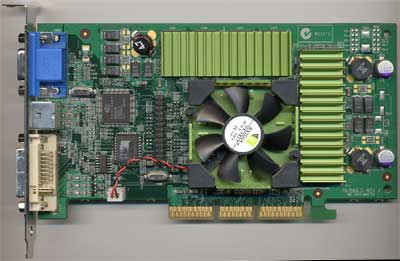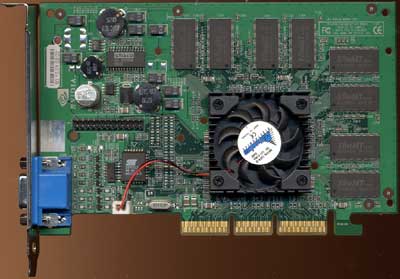
Original Link: https://www.anandtech.com/show/831
NVIDIA's Fall Product Line: GeForce3 Titanium
by Anand Lal Shimpi on October 1, 2001 9:00 AM EST- Posted in
- GPUs
It's yet another fall and while it's not as happy of a time as it was a year or two ago, the technology companies are continuing on as usual. It's now tradition to expect to see one or more new NVIDIA graphics card designs released every fall, just as they are done six months later in the Spring. This tradition is a byproduct of NVIDIA's very aggressive six month product cycles, something that keeps competitors on their toes as well as quickly brings high graphics performance down to affordable price points.
Just six months ago we were writing about NVIDIA's revolutionary GeForce3; and in spite of how revolutionary the product was we didn't recommend it as a card to purchase. The first cards were priced too high and the added features and performance the card offered would not give you any tangible improvement in the majority of today's games. For those of you that purchased for the long run and don't plan on upgrading your video cards for a while, you probably made the right decision. For everyone else that did purchase GeForce3s recently, will NVIDIA's marketing line from one of the three cards being announced today will make you want to kick yourself? We're going to show you if the line "GeForce3 performance, at half the price" can really hold true.
This fall we are all getting the "refresh" to the GeForce3 line that we told everyone to wait for months ago. While this refreshed GeForce3 line means greater performance, it also means lower prices for GeForce3 class performance which is never a bad thing.
Relaxed Marketing: Titanium
NVIDIA has rarely had any problems with the branding on their products and their fall line continues the tradition of simple marketing by adding the "Titanium" name to all new products.
As we just mentioned, there are three products being announced today all of which will be available immediately. The products are:
GeForce3 Ti 500
GeForce3 Ti 200
GeForce2 Ti 200
The "Ti" obviously stands for Titanium, and the number actually denotes the effective memory clock of the card. There's your first tidbit of technical information, now it's time to see what else is new about these three cards.
Not new, just faster
| Let's start with NVIDIA's new flagship, the GeForce3 Ti 500. The GeForce3 Ti 500 is supposed to offer "1.5x GeForce3 performance at [the] same price"; as you'll see from our benchmarks, this isn't exactly the case when you test both cards on a level playing field. | 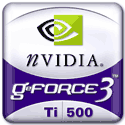 |
The GeForce3 Ti 500 is akin to the GeForce2 Ultra in that it is a lower yield, higher clock speed part coupled with faster than normal memory. More specifically, the Ti 500 is clocked at 240MHz core and features 250MHz DDR SDRAM (effectively 500MHz). Compared to the original GeForce3, the Ti 500 has a 20% higher clock speed and almost a 9% higher memory clock. You can already tell that there's no way the Ti 500 will be 1.5x faster than the GeForce3. This card will be priced at $349.99 - $399.99.
NVIDIA's GeForce3 Ti 500 Reference Board
| The next and possibly most interesting card out of this lineup is the GeForce3 Ti 200. This is actually a much easier chip for NVIDIA to make since it features a lower core clock speed than the original GeForce3. A lower core clock speed means that more chips can be sold thus reducing the cost of manufacturing. The GeForce3 Ti 200 core is clocked at 175MHz and the memory clock is reduced to 200MHz DDR (400MHz effective). | 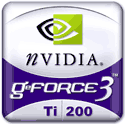 |
The reason NVIDIA can claim "GeForce3 performance" out of this part is because in most real-world cases you are memory bandwidth limited, not fill rate bound meaning that core clock speed isn't as important. The reduction in memory bandwidth does reduce overall performance however making it unlikely that the GeForce3 Ti 200 would be able to keep up with the GeForce3. It'll be close, but definitely no cigar. The GeForce3 Ti 200 is intended to compete with ATI's Radeon 7500 and is priced at $199.
Both of the GeForce3 Ti cards share the same features as the original GeForce3; for more information on those features have a look at our original GeForce3 Technology Overview.
NVIDIA's GeForce2 Ti 200 Reference Board
| The final card being released is the lower end GeForce2 Ti 200. This card bumps the GeForce2's clock speed back up to 250MHz (where the Ultra debuted at) while keeping the memory clock at 200MHz DDR (effectively 400MHz). This card will be priced at "GeForce2 Pro levels" meaning $149 - $179. The feature set of the GeForce2 Ti 200 is identical to the GeForce2 Pro. | 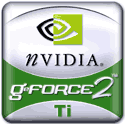 |
Playing the clock speed game
It's clear from this latest round of graphics card releases that AMD and Intel aren't the only ones that play the clock speed game in this industry. In response to NVIDIA's Titanium threat, ATI has cranked up the clock speed on their Radeon 7500 card. However they did not increase the memory clock speed, just the core clock. So the Radeon 7500 will now ship at 290MHz core (instead of 270MHz) with 230MHz DDR SDRAM. In virtually any game at 1024 x 768 x 32 this increase in clock speed will buy you a whopping 0 - 3% performance increase.
NVIDIA isn't innocent of playing this same game either. We were surprised when our GeForce3 Ti 500 reference board came clocked at 240/258 (core/mem) instead of the 240/250MHz NVIDIA had said the card would be shipping at. When we asked NVIDIA their response was that "OEM cards are clocked at 240/258MHz while retail cards will be clocked at 240/250MHz." Their reason for doing this was to give the OEMs a little extra performance; how much extra? You guessed it, 0 – 3%.
Why would ATI and NVIDIA even bother with small clock speed increases (7% for ATI and an even smaller 3% for NVIDIA)? Remember that they have to play the same clock speed games when marketing their cards to large OEMs (where both ATI and NVIDIA make the vast majority of their money). Higher clock speeds are definitely checkbox features that OEMs can appreciate. At the same time, in situations where two cards perform very close to each other, percent or two can change performance standings in a bar graph quite dramatically. This is one reason you should always look at the tangible improvement, not just the position of a bar on a graph.
In the case of the GeForce3 Ti 500 we chose to test at the clock frequency that the retail cards would be shipping at, 240MHz core and 250MHz memory. If you're curious as to how a 258MHz card would perform, just imagine another percent or two tacked on to the frame rate.
The Competition
A little over a month ago we provided you with a preview of ATI's two new graphics cards, the Radeon 7500 and 8500. Apparently ATI has been hard at work on drivers for the 8500 in particular, attempting to not only match but exceed the performance of the GeForce3. In spite of our requests to have a final card and final drivers ready for today, ATI wasn't able to get us everything in time. The final Radeon 8500 with final drivers will be in our hands (according to ATI) sometime this week, and we'll provide you with a final look at that card when we have it. The performance of our original sample is too poor to report here again, but if you're interested you can go back to our original preview. If the Radeon 8500 can indeed offer better performance than the GeForce3 then it could be very attractive simply because it will be priced below $300.
The Radeon 7500 is not as impressive unfortunately. As we mentioned in our original preview, the card needs to be cheaper if it is to compete with the GeForce2 Pro and now the GeForce3 Ti 200. The only differences between the shipping Radeon 7500 and the one we previewed in August is that it now has a 20MHz higher core clock and has slightly improved drivers. ATI was not able to provide us with shipping Radeon 7500 drivers in time for this review but we used the 5.13.3249 drivers they provided us with earlier for the 7500 benchmarks. The major changes in the final revision of the drivers are seemingly bug related and not performance related.
Competitive Feature Comparison Chart
|
ATI
|
NVIDIA
|
STMicro
|
||||||||
|
Radeon
|
Radeon
7500
|
Radeon
8500
|
GeForce2
Pro
|
GeForce2
Ti 200
|
GeForce2
Ultra
|
GeForce3
|
GeForce3
Ti 200
|
GeForce3
Ti 500
|
Kyro
II
|
|
| Number of Transistors |
30M
|
30M
|
60M
|
25M
|
25M
|
25M
|
57M
|
57M
|
57M
|
15M
|
| Manufacturing Process (circuit width in microns) |
0.18
|
0.15
|
0.15
|
0.18
|
??
|
0.18
|
0.15
|
0.15
|
0.15
|
0.18
|
| Rendering Pipelines |
2
|
2
|
4
|
4
|
4
|
4
|
4
|
4
|
4
|
2
|
| Texture Units per Pipeline |
3
|
3
|
2
|
2
|
2
|
2
|
2
|
2
|
2
|
1
|
| Core Clock Speed (MHz) |
183
|
290
|
275
|
200
|
250
|
250
|
200
|
175
|
240
|
175
|
| Memory Clock Speed |
183
|
230
|
275
|
200
|
200
|
230
|
230
|
200
|
250
|
175
|
| Memory Bus |
128-bit
DDR
|
128-bit
DDR
|
128-bit
DDR
|
128-bit
DDR
|
2
x 64-bit DDR
|
2
x 64-bit DDR
|
2
x 64-bit DDR
|
128-bit
SDR
|
||
| Memory Bandwidth (GB/s) |
5.8
|
7.4
|
8.8
|
6.4
|
6.4
|
7.4
|
7.4
|
6.4
|
8.0
|
2.8
|
| Special Features |
HyperZ
|
HyperZ
|
HyperZ
II
SmoothVision |
Lightspeed
Memory Architecture
HRAA |
Deferred
Renderer
|
|||||
Drivers and FSAA Performance
We already established that Windows 2000 and XP drivers had matured considerably in our Radeon 8500 preview so we will refrain from going through that set of tests again here. In our forthcoming Radeon 8500 review we'll take a closer look at driver performance in various OSes.
Since there are no new FSAA modes offered in any of the Titanium cards we'll again focus on FSAA in our 8500 review.
The Test
Our testing methodology for this review is similar to what we used in our Radeon 8500 preview. The only differences being that we added another resolution to test at (1600 x 1200 x 32) and we are now testing using the latest drivers from all manufacturers on an Intel Pentium 4 2.0GHz platform.
We used a slightly newer version of the Detonator XP drivers (v21.85) for this test. Performance didn't improve any over the original Detonator XPs however these drivers properly recognize all of the Titanium cards.
|
Windows 98/2000/XP Test System |
||||||
|
Hardware |
||||||
|
CPU(s) |
Intel Pentium 4 2.0GHz | |||||
| Motherboard(s) | ABIT TH7-II RAID | |||||
| Memory |
256MB PC800 Mushkin RDRAM |
|||||
| Hard Drive |
IBM Deskstar 30GB 75GXP 7200 RPM Ultra ATA/100 |
|||||
| CDROM |
Phillips 48X |
|||||
| Video Card(s) |
ATI
Radeon 7500 64MB DDR NVIDIA
GeForce3 Ti 500 64MB DDR Hercules 3D Prophet 4500 64MB SDR |
|||||
| Ethernet |
Linksys LNE100TX 100Mbit PCI Ethernet Adapter |
|||||
|
Software |
||||||
|
Operating System |
Windows 2000 Professional Service Pack 2 |
|||||
| Video Drivers |
|
|||||
Black & White
A very different type of game than what you're used to seeing in these reviews, Black & White places you in control of a civilization as their god. This Direct3D game relies on a high enough frame rate that navigating around your worshippers' villages isn't choppy. The user has a third person perspective of the world.
The game was set to 1024 x 768 x 32/1600 x 1200 x 32 with the preset maximum detail configuration used. We used fraps to take the average frame rate during the intro scene with the family and their child journeying towards the water (the movie was skipped). Note that the latest version of fraps does take an actual average frame rate so this is not an estimate.
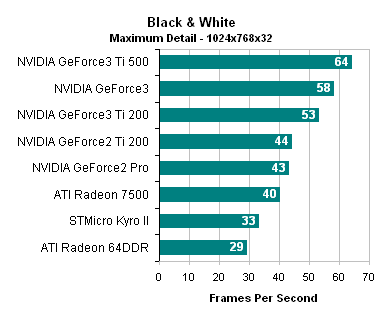
At 1024 x 768 x 32 the GeForce3 Ti 500 is 10% faster than the GeForce3; the GeForce3, in turn is 9% faster than the GeForce3 Ti 200. As you'd expect, the GeForce2 Ti 200 and the GeForce2 Pro are almost identical in performance since they have the same amount of memory bandwidth. Both of those cards are 10% faster than the Radeon 7500.
Even the T&L-less Kyro II is faster than the regular Radeon 64DDR in this test.
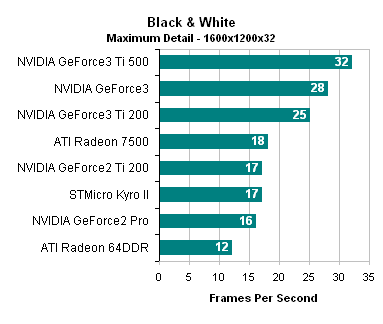
At 1600 x 1200 the cards with the greatest amount of memory bandwidth or most efficient usage of what they have rise to the top. The Ti 500 is still untouchable and 14% faster than the GeForce3. The Radeon 7500 moves up a few notches but is still slower than the comparably priced GeForce3 Ti 200.
The Kyro II moves up another notch in the standings but mainly because the GeForce2 Pro doesn't have efficient enough use of its memory bandwidth to maintain its previous lead.
Quake III Arena
One of the most reliable gaming benchmarks (its results are always repeatable and rarely vary) is Quake III Arena and it's based on an engine that is still in the news. We used the 1.29g patch and the video options set to the default High Quality settings. The resolution was adjusted and demo 'four' was run in timedemo 1 mode.
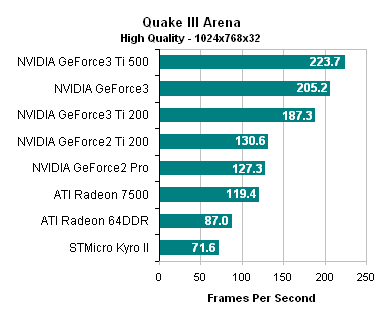
If you're a Quake III Arena fan you should be very happy. Could you have imagined seeing 223 fps at 1024 x 768 x 32 in this game when it first came out? We were lucky to break 40 fps back then.
The standings don't change too much under Quake III Arena; the GeForce3 Ti 500 has a 9% lead over the GeForce3. The lower memory clock of the GeForce3 Ti 200 explains the 10% performance advantage the GeForce3 holds over this newcomer.
Again, the GeForce2 Ti 200 and the GeForce2 Pro perform virtually identically. The two GeForce2 cards are about 6 - 9% faster than the Radeon 7500.
Had the Radeon 7500 come out earlier it would have been a welcome upgrade for many ATI fans considering the performance of the original Radeon in this test; but with the GeForce3 Ti 200 being sold at the same price as the Radeon 7500, it's a very difficult fit in today's market.
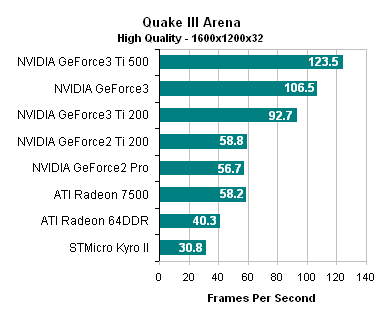
Cranking up the resolution produces the expected results. The truly impressive thing to note is that both the GeForce3 Ti 500 and the original GeForce3 can run Quake III Arena at full detail, at 1600 x 1200 x 32 and maintain over 100 fps.
Wolfenstein MP Test
In the tradition of id releases, the upcoming Return to Castle Wolfenstein game was introduced in a publicly available Multiplayer Online Test. If you haven't tried the game yet we suggest downloading a copy and enjoying it yourself. The game is based on a modified version of the Quake III engine with an updated look to the graphics. We recorded two quick demos for this test by hopping on a random online server and going at it for a few; one outside on the beach with many players visible and some very big explosions and the other inside the compound with very few players. You can download the two demos here.
We tested with the built in "High Quality" settings enabled and texture filtering changed from Bilinear to Trilinear. To run the benchmark do the following:
1) Extract the demo files to c:\PathToWolfMPTest\demomain\demos\
2) Bring down the console by hitting the '~' key
3) Type 'timedemo 1' and hit enter
4) Type 'demo atdemo6' and hit enter to run the first demo, or 'demo atdemo8'
to run the second demo.
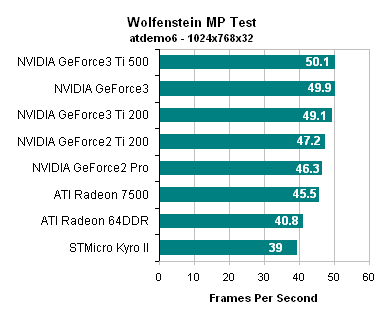
As you can see this first demo is very stressing on the overall platform. With the exception of the Radeon 64DDR and Kyro II, all of the cards perform within about 10% of one another. To improve the worst case scenario performance in Wolfenstein it looks like you're going to need more than just a fast video card.
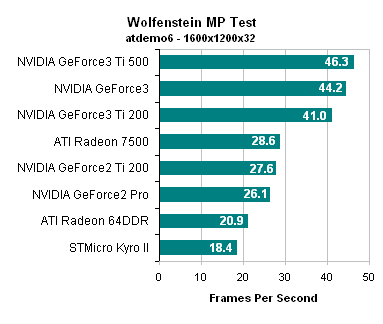
At 1600 x 1200 we see memory bandwidth limitations come into play as the three GeForce3 cards take the lead. The Radeon 7500 is able to slightly nudge the newcomer GeForce2 Ti 200 out of its fourth place position. Again, the Radeon 7500 is no where near the performance of the GeForce3 Ti 200.
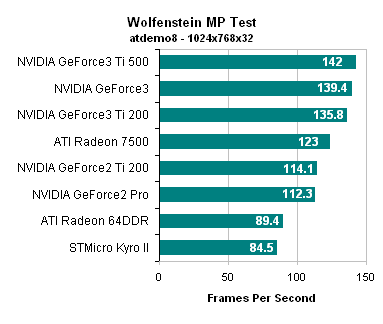
Without much action going on the performance of the cards skyrocket, but they are still not able to reach the Quake III Arena frame rates just yet. Obviously the game isn't final yet so we can expect to see some improvements in performance but the standings should not change much at all.
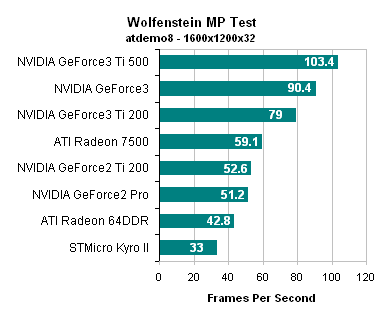
Again we see some very respectable frame rates out of the top three or four cards but the real concern should be how low the frame rate will drop which we've already showed you is more than half of what you see here.
Max Payne
Short but sweet is the best way to describe Max Payne. The game will definitely leave you wanting more not only in terms of the game but in your hardware as well. We debuted this benchmark in our Detonator 4/XP and Radeon 8500 articles. The guys at 3D Center have great instructions on how to benchmark Max Payne (including how to use the AnandTech benchmark).
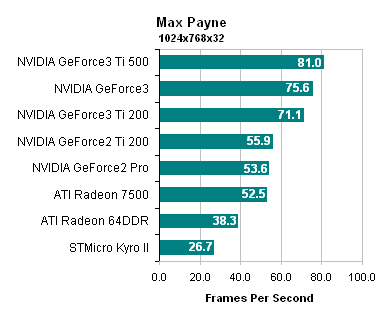
The standings in Max Payne don't change much from what we've already seen. The performance gaps between the cards definitely shrink as Max Payne is actually highly dependent on CPU/platform performance, even at 1024 x 768. This is why the Ti 500 is only 7% faster than the GeForce3 and why the GeForce3 and the GeForce3 Ti 200 are only separated by 6 percentage points.
The GeForce2 Ti 200, GeForce2 Pro and Radeon 500 fall into the usual clump and the trailing two candidates don't change much either.
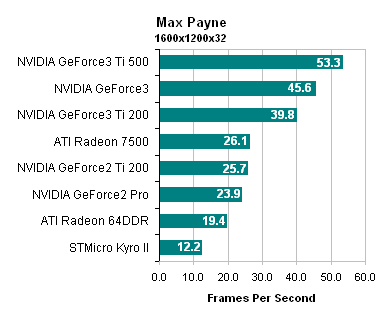
As usual, the only change here is that the performance difference between the cards increase with memory bandwidth differences. The GeForce3 Ti 500 now commands a 16% lead over the GeForce3; over twice the lead it held at 1024 x 768.
UnrealTournament
Although at this point it's a better CPU benchmark than a video card benchmark, UnrealTournament as usual is a part of our standard test suite. We tested using the publicly available "Thunder" demo by Reverend.
Unfortunately the 5.13.3249 drivers seemed to have problems with UT as the scores are unusually low. We'll provide updated benchmarks in our upcoming 8500 review.
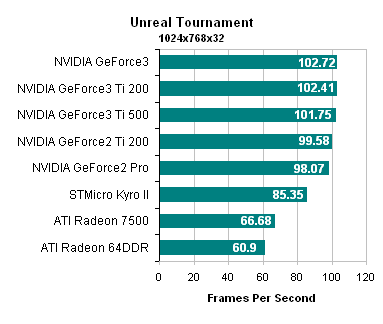
At 1024 x 768 x 32 there's little separating any of the top performers, they are all basically the same.
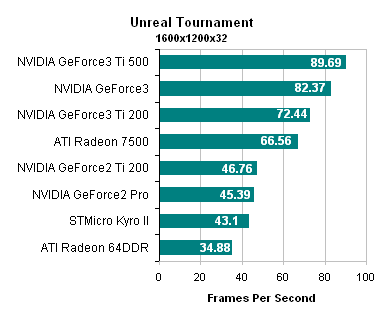
It's only when you crank the resolution up to 1600 x 1200 that you can begin to see differences in performance between the various cards. This turns the benchmark into more of a memory bandwidth test. You can see that the Radeon 7500 does much better than its predecessor here in spite of the apparent driver problems with this benchmark.
Serious Sam
As Croteam is hard at work on the followup to Serious Sam we continue to use it as a benchmark since the game makes use of many newer graphics features. For our tests we set all of the graphics options to their maximum values with the exception of ansiotropic filtering which was left disabled.
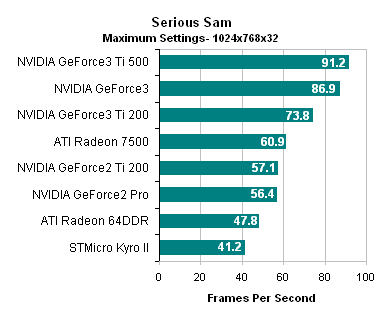
The picture doesn't change much in Serious Sam either; by now you should have a very good idea of how these cards perform.
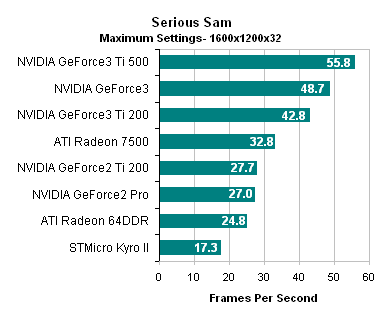
One of the great things about Serious Sam is that it has a built in synthetic test which will use its own engine to give you real world fill rate numbers. The numbers below is the real world multitextured fill rate for all of the cards using the Serious Sam engine with 32-bit color enabled.
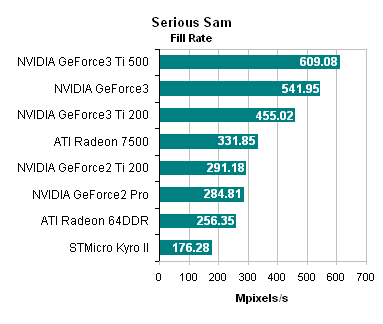
This is where you realize how meaningless theoretical fill rates are. NVIDIA claims the GeForce3 Ti 500 is capable of rendering 3.8 billion Anti Aliased pixels per second. This test right here shows off a real world fill rate of just over 600 million pixels per second. Enabling Anti Aliasing would cut that number in half at least.
You can also see why the Radeon 7500 isn't able to keep up with the GeForce3 Ti 200 in any of these benchmarks in spite of its efficient memory bandwidth utilization courtesy of HyperZ. The Radeon 7500 can only offer about 3/4 the real world fill rate of the GeForce3 Ti 200.
3DMark 2001
While far from our favorite benchmark, 3DMark 2001 is useful for showing off some of the theoretical performance figures of these cards.
|
Multitextured
Fill rate (MTexels/s)
|
Triangle
Rate (MTriangles/s)
|
EMBM
(fps)
|
DOT3
(fps)
|
Vertex
Shader (fps)
|
Pixel
Shader (fps)
|
Point
Sprites (MSprites/s)
|
|
| ATI Radeon 7500 |
1076.3
|
2.6
|
95.1
|
53.8
|
34.9
|
NS
|
0.2
|
| ATI Radeon 64DDR |
736.2
|
1.7
|
71.4
|
42.5
|
35.8
|
NS
|
0.2
|
| NVIDIA GeForce3 Ti 500 |
1579
|
3.7
|
116.2
|
124.2
|
54.3
|
90.2
|
17.7
|
| NVIDIA GeForce3 Ti 200 |
1165.6
|
2.7
|
95.4
|
93.5
|
43.1
|
67.4
|
13
|
| NVIDIA GeForce3 |
1331.5
|
3.1
|
104.3
|
107.2
|
47.6
|
76.8
|
14.8
|
| NVIDIA GeForce2 Ti 200 |
626.3
|
3.7
|
NS
|
46.5
|
38.8
|
NS
|
8.5
|
| NVIDIA GeForce2 Pro |
620.9
|
2.9
|
NS
|
45.6
|
38.5
|
NS
|
8.4
|
| STMicro Kyro II |
343.2
|
1.2
|
78.8
|
37.4
|
15.6
|
NS
|
0.6
|
Take these numbers for what you will but you've already seen how these cards perform in the real world.
Final Words
To summarize the performance trends we've seen:
- The GeForce3 Ti 500 is approximately 10% faster than the GeForce3 at 1024 x 768 x 32; 16% at 1600 x 1200 x 32.
- The GeForce3 is approximately 9% faster than the GeForce3 Ti 200 at 1024 x 768 x 32; 14% at 1600 x 1200 x 32.
- The GeForce2 Ti 200 is identical in performance to the GeForce2 Pro.
- The Radeon 7500 is competitive with the GeForce2 Ti 200, not with the GeForce3 Ti 200.
- The Radeon 8500 has more memory bandwidth than the GeForce3 Ti 500.
Starting at the top, the GeForce3 Ti 500 makes gaming at 1280 x 1024 and 1600 x 1200 more of a reality than the GeForce3 could. Obviously for current GeForce3 owners there's no reason to make the switch but if you're looking to upgrade to the absolute fastest available today, then this is the card to get.
The GeForce3 actually ends up being a very attractive purchase at this point, since in theory the GeForce3 Ti 500 would drive its price down. What is more likely to happen however is that as soon as current supplies dry up, NVIDIA will increase the price on regular GeForce3 chips and essentially only make it viable for manufacturers to produce Titanium cards. This would be much like what NVIDIA did with the Ultra when the GeForce2 Pro was released.
The GeForce3 Ti 200 is by far the best buy and is clearly a better value than the Radeon 7500 (remember that they are priced equally). At 1024 x 768 x 32 in most games you do get performance that's very close to that of the original GeForce3. It's without a doubt that our recommendation is to purchase the GeForce3 Ti 200 unless you can find a cheaper GeForce3 card.
While the GeForce2 Ti 200 was supposed to revolutionize the mainstream add-in card market, it actually doesn't do much more than the GeForce2 Pro was already doing. If you look carefully enough, you can find OEM GeForce2 Pro cards selling for the $149 price tag that the GeForce2 Ti 200 will debut at. Hopefully this will make the current stock of GeForce2 Pro cards decrease in price even more, making them the killer buy. But in the long run, you get the same performance out of either of the two.
As we just alluded to, the Radeon 7500 is in desperate need of a price cut or a performance boost. Although it can easily outperform the GeForce2 Ti 200, it is priced competitively with the GeForce3 Ti 200; and the GeForce3 Ti 200 can clearly outperform it while offering full DirectX 8 support (which will hopefully matter someday).
The real gem to wait for before making your buying decision however is the Radeon 8500. While we were thoroughly unimpressed with the Radeon 7500 this late in the game, the Radeon 8500 has the potential to turn things around for ATI. It will be another six months before we see another card from NVIDIA, and the Radeon 8500 definitely has the memory bandwidth to outperform the GeForce3 Ti 500.
The only thing that could potentially hold ATI back are drivers which have been their Achilles' heel for the longest time. The latest build of Radeon 8500 drivers are supposed to be ATI's best, hopefully within this week we'll be able to see exactly how good ATI's best is.

